|
In TCM external medicine, treatment is classified into two categories: oral medications and external applications. The oral medications are similar to the approaches used in internal medicine, since they are applied according to syndrome differentiation. However, some therapeutic guidelines and herbal usages are unique, particularly in the treatment of wound infections.
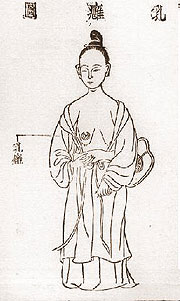 |
| Breast abscess |
For the management of wound infections, western medicine stresses quarantine, sterilization and drainage to cut off the infected source, or kill the pathogens directly by antibiotics. The body's overall condition is usually not a crucial factor to take into account, unlike TCM. The TCM physician will carefully identify the disease stage of the individual and then treat them specifically. Generally, TCM divides wound infections into three phases: the infected phase, the pus-formed phase and the ulcerated phase. Dispersion, supporting and invigoration are the three therapeutic principles devised for each of the phases respectively.
Dispersion refers to approaches used in newly formed infections, when localized conditions show redness, swelling, heat or pain. Physicians will focus on the elimination of signs and the control of infections. In order to design a customized treatment, individual constitutions, affected meridians and yin yang categories are usually considered.
Supporting refers to approaches used when the lesion begins to change into an abscess. Physicians will focus on invigorating qi and blood, as well as promoting pus drainage. This enables the wound to stop further spreading and to start to heal smoothly.
Invigoration refers to approaches used when the site begins to heal or tends to become chronic. Physicians will use invigorating drugs to increase body resistance and promote regeneration of tissues.
Practically, internal therapies employed by external medicine work in the following ways:
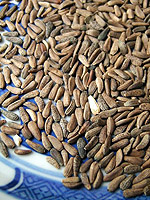 |
| Great burdock fruit |
1. Inducing sweating (diaphoresis)
This method is used for dispelling pathogens from the surface of the body. Our skin is the outermost shelter from exogenous pathogens, so when it is disturbed, symptoms such as chills, fever, headache, sweating problem, neck stiffness, generalized aches and a floating pulse will appear. Herbs pungent in flavor and with cooling or warming properties are used. In external medicine, physicians usually use this therapy for infections of the upper body or skin problems such as hives, cervical carbuncles or acute mastitis.
Sample Prescription: Great Burdock Fruit Decoction for Releasing Muscles (Niu Bang Jie Ji Tang). The formula comprises mostly of pungent and cool ingredients that dispel pathogens from the body's surface so as to expel wind and heat, and alleviate phlegm and swelling.
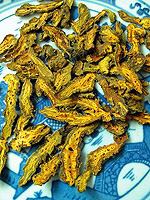 |
| Golden thread rhizome |
2. Purgation
In TCM, this method is not only used for relieving intestinal stagnancy, but also for removing accumulated heat, fire, toxins and even retained fluid inside the body. Physicians usually use this technique for conditions associated with high fever, thirst, irritability, constipation, abdominal distention, a red tongue with yellow and greasy fur, and a rapid pulse. In addition, constipation can be caused by inadequate lubrication in the stomach and intestines; people with this condition need extra moisture to promote bowel movements.
Sample Prescription: Golden Thread Rhizome Decoction for Dispersion (Nei Shu Huang Lian Tang). In the prescription, golden thread rhizome and rhubarb serve as the main ingredients for purgation. The whole combination works by promoting bowel movement to remove stagnations, so that the toxic fire and heat can be expelled through bowel movements.
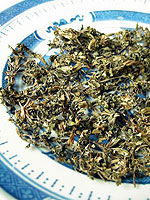 |
| Tokyo violet herb |
3. Clearing heat
This is an important method for treating various heat syndromes. Individuals with these syndromes usually present with fever, thirst, prefer cold drinks, constipation, scanty and yellowish urine, tongue covered by yellow coating. In external medicine, it is used especially for yang syndromes; lesions that show obvious redness, heat, pustules, running sores or deep-rooted ulcers, for example, carbuncles, erysipelas, multiple abscesses, osteomyelitis, contact dermatitis, impetigo, lupus erythematosus, psoriasis and large-scale burns. TCM holds that attacking heat evils can accumulate in different parts of the body, e.g. heart, lungs, bones, qi or blood. By choosing herbs with cold or cool properties, physicians can target areas where heat or fire is located.
Sample Prescription: Five Flavors Drink to Expel Toxins (Wu Wei Xiao Du Yin). In the prescription, all ingredients have a cold property, which can forcefully clear toxic heat and arrest infections. It is suitable for many kinds of infection.
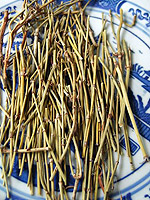 |
| Ephedra |
4. Warming
In this method, herbs with warm and hot properties are used to dissolve phlegm, eliminate wind and dampness and activate meridian flows. Physicians usually apply this technique in conditions caused by coldness and phlegm that has accumulated in the bones and tendons. Clinical features include localized soreness, multiple nodules without heat and redness, fatigue, profuse clear urine, chills, a deep and slow pulse; these can appear in early stages of leprosy, tuberculosis of the bones and joints and gangrene in the fingers and toes .
Sample Prescription: Decoction for Harmonizing Yang (Yang He Tang). The whole prescription focuses on fortifying yang and replenishing blood, which helps to expel coldness and dissolve phlegm. It is indicated for tuberculosis of the bones and joints, or septic infections that are categorized as yin syndromes.
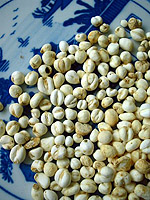 |
| Thunberg fritillary bulb |
5. Eliminating phlegm
TCM holds that phlegm accumulation is closely associated with the formation of masses or swellings; however, phlegm is not the primary cause in most cases, but a pathological product arising from internal qi stagnation. Clinically, it customary for physicians to use herbs with salty and cold properties to eradicate swelling or soft masses, and it is usually employed in conjunction with other methods, such as dispersing wind, unblocking stagnation or nourishing blood, in order to obtain the most effective result.
Sample Prescription: Decoction of Nutgrass and Fritillary for Nourishing (Xiang Bei Yang Ying Tang). This prescription aims at replenishing blood and qi, smoothing their flows and dissolving phlegm, making it suitable for individuals with tuberculosis or breast cancer which has developed a long period of time.
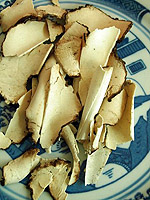 |
| Poria |
6. Eliminating Dampness
This method is indicated for conditions with effusions such as eczema, chronic sores and contact dermatitis. It includes resolving dampness with aromatics, promoting urination and drying dampness by desiccating herbs. Generally, most external diseases are affected by multiple factors, for example, abscesses forming in the soft tissue behind the knee or affecting the bone are also due to the influence of heat; abscesses in the breast, navel and scrotum sores or herpes zoster also involve Liver Meridian pathology; vitiligo is due to wind and dampness attacking the muscles and body surface. Therefore, methods like heat clearing, expelling wind and dispelling coldness are often combined.
Sample Prescription: Five-God Decoction (Wu Shen Tang). The prescription aims at clearing heat and inducing urination. Poria serves as the main ingredient to induce urination; honeysuckle flower; plantain seeds and Tokyo violet herb assist to clear the heat; achyranthes root guides the herbs to work on the lower part of the body and also promotes blood flow of the affected area. This makes it suitable for septic infections in the lower part of the body, such as abscesses behind the knee, septic osteomyelitis and perianal abscess.
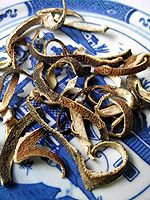 |
| Green tangerine peel |
7. Moving qi
This method is usually employed for dissolving swelling or lumps and relieving pain. TCM believes that most external diseases have pathological changes resulted from blood and qi stagnations, and many are related to liver qi stagnation, for example goiter, breast lumps or breast cancer. Thus, this method mainly focuses on soothing the liver.
Sample Prescription: Decoction for Clearing the Liver and Relieving Stagnation (Qing Gan Jie Yu Tang). The prescription aims at clearing the liver, moving qi and dissipating the accumulation. It is suitable for breast lumps.
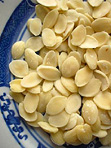 |
| Peach kernel |
8. Harmonizing blood
In external diseases, in particular skin problems, one of the major pathologies is circulatory disturbance of yang energy in the blood vessels, which can be treated by using herbs to smooth meridian flow and restore blood condition. Thus the method is widely used in TCM external medicine. Some conditions where this method is employed include nodules, warts, keloid, capillary dilations, purpura and thickness.
Sample Prescription: Decoction for Activating Blood and Relieving Firmness (Huo Xue Hua Jian Tang). The prescription aims at activating blood, removing stasis and dissolving firmness, which is a suitable treatment for the initial stage of swellings caused by a combined influence of qi stagnation, stasis and phlegm such as thyroid lumps, lymph node tuberculosis and tumors.
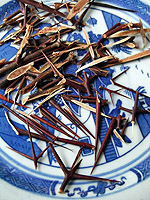 |
| Chinese honeylocust spine |
9. Supporting
In order to localize the infected area and control further spreading, physicians focus on promoting the liquefaction of the abscess to facilitate pus drainage. This helps the infected area to commence the healing process. TCM will further identify whether the body's resistance is capable of sustaining the pus formation process, if not, then invigorating health energy should also be incorporated.
Sample Prescription: Powder for Promoting Pus Drainage (Tou Nong San). The prescription aims at enabling the abscess to mature and rupture, which is suitable for an un-ruptured abscess or an abscess that hasn't drained properly after rupture.
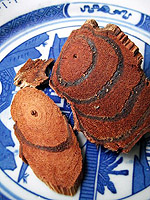 |
| Suberect Spatholobus stem |
10. Invigoration
In TCM external medicine, this method is employed in the late stage of disease development or when individuals show different signs of weakness. For example, if the wound is difficult to close and the pus appears thin and clear, then the blood should be nourished and the qi replenished. However, when individuals present with a skinny and pale appearance, fatigue and mouth dryness, then yin should be nourished and body fluid production promoted. If there is extensive septic infection accompanied with darkish ulcers, then the patient's condition should be enhanced by warming and replenishing qi. Generally, invigorating drugs are used to increase resistance and so promote tissue growth.
|